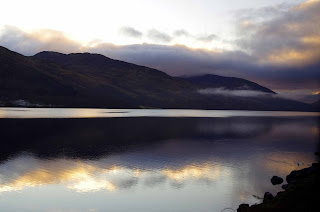We had a few days away up in Tyndrum, Scotland on a coach tour with Highland Heritage. The weather could have been better but it was still a very nice break. The hotel was The Royal and cant be faulted, the rooms, the food and staff were all excellent. There were trips out every day but i had been to all of them so i stopped in a couple of days and had a walk along part of the West Highland Way. Just strung a few pics together of some of the places visited.
 |
| River rapids just north of Tyndrum Lower railway station |
 |
| Looking north from Tyndrum Lower railway station |
 |
| The start of my walk at Kirkton Farm where i got dropped off from the coach. |
 |
| Graveyard opposite St. Fillan's Priory |
St. Fillan's Priory a
ruined small religious
house lying next to Kirkton Farm, on the left bank of the River Fillan, 2 miles (3 km) southeast of Tyndrum and 3 miles (5 km) northwest of Crianlarich,
St. Fillan's Priory was established by Robert the Bruce in 1318 close to the site of an older foundation. St. Fillan had brought Christianity from Iona in the 8th century
and created a monastic settlement at nearby Auchtertyre. Following his defeat
at the Battle of Methven in 1306, Bruce was granted sanctuary at the old chapel
here. In gratitude gave land to build a new foundation, and the church at
Killin, to the Augustinian monks of Inchaffray Abbey on condition they maintain the new priory.
Alistair MacDougall, seeking revenge for Bruce's murder
of John Comyn, tracked down Bruce and his men to
the priory. A battle ensued in a nearby field, now known as Dalrigh (the
King's Field) in which Bruce and his men fought bravely against greatly
superior numbers before being forced to flee. In retreat, Bruce's men threw
their heavy arms into the tiny Lochan nan Arm, where they are thought to
remain to this day.By 1607 the priory had become the property of the
Campbells. Little remains of the building as
the stones were quarried to construct the neighbouring farmhouse and its
outbuildings. A half-mile (0.8 km) to the northwest is
St. Fillan's Holy Pool, which was blessed by
the saint and said to cure insanity.
 |
| The remains of St. Fillans Priory |
 |
| Looking south towards Ben More on the left. |
 |
| Looking north towards Dalrigh |
 |
Me, having a rest on the West Highland Way.
The West highland Way stretches from Glasgow to Fort William and is 96 miles
long.
|
 |
| Wigwams at Strathfillan with the Fort William railway line above. |
 |
| Waterfall at Strathfillan Wigwams |
 |
| Waterfall at Strathfillan Wigwams |
 |
| Old road bridge over the river Fillans |
 |
St. Fillans Holy Pool where insane people were treated.
St Fillan's Holy Pool is a natural, deep pool at a sharp bend in the River Fillan. There is now no evidence of stonework but the pool was once divided by a stone dyke into male and female sides. |
The Battle of Dalrigh, also known as the Battle of Strathfillan, was fought in the summer of 1306 between the
army of King Robert I of Scotland against the Clan MacDougall of Argyll who were
allies of Clan Comyn and the English. It took place at
the hamlet of Dalrigh (the "King's Field" in the Scottish Gaelic language)
near Tyndrum in Argyll, Scotland. Bruce's army, reeling westwards after defeat by
the English at the Battle of
Methven, was intercepted and all but destroyed, with Bruce himself
narrowly escaping capture. The battle took place sometime between late July and
early August, but the exact date is unknown.
 |
| The caption on this stone seat relates to the nearby site of the Battle of Dalrigh 1306. |
 |
| If you look very carefully bottom right hand corner you may see 2 faces in the rocks. |
 |
| I made a detour from the West Highland Way and went on towards the Gold mine at Cononish |
 |
| The river Cononish |
 |
| Long and winding and steep road to the only gold mine in Scotland. |
Cononish Gold Mine
In 1984 a gold bearing quartz vein was discovered by the Irish firm Ennex International on the lower south eastern slopes of Beinn Chùirn just above Cononish Farm at Eas Anie. The company spent over £250,000 doing test drillings and were hopeful that the mine would be very productive. The gold, which is the most important deposit found in Scotland so far, occurs as minute particles inside Pyrite and Galenawhich in turn occur in the quartz vein.
 |
| Cononish gold mine on the hillside centre right |
 |
| Me, just checking my position on my GPS. |
 |
| Fallen trees just above the Lower railway station in Tyndrum |
 |
| Back of the Royal Hotel |
 |
| Train leaving Tyndrum Lower Station |
 |
| Front of the Royal Hotel |
 |
| Me in the lift after walking nearly 7 miles humping a heavy tripod, absolutely knackered. |
 |
| En route to Crieff |
 |
| In the TI shop Crieff |
 |
| Original stocks in the TI shop Crieff |
 |
| In the TI shop Crieff |
 |
| Clock decorated with candies shop window in Crieff |
 |
| Crieff water fountain |
The next few pics were all taken from the coach window at 30mph.
 |
| Proper Scotch mist |
Went all the way to Scotland looking for snow, got none, been back home 2 days and got 2" this morning. Thats life.
Cheers



















































No comments:
Post a Comment